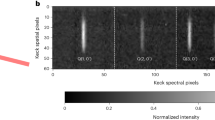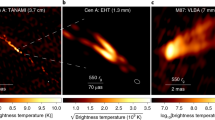Abstract
OBSERVATIONS have been made at a wave-length of 3.7 m. with interferometers of different resolving powers to determine the distribution of radio brightness across the Andromeda nebula, M31, which has also been investigated at radio wave-lengths by Hanbury Brown and Hazard1. When observations are made with small movable aerials, errors are caused by reception of radiation from adjacent radio stars. Good discrimination was therefore obtained with the present measurements by using several different sections of the large Cambridge radio telescope2, although this method reduced the number of different axes and aerial spacings available. The relationship of the four axes used to the Andromeda nebula is shown in Fig. 1.
This is a preview of subscription content, access via your institution
Access options
Subscribe to this journal
Receive 51 print issues and online access
$199.00 per year
only $3.90 per issue
Buy this article
- Purchase on Springer Link
- Instant access to full article PDF
Prices may be subject to local taxes which are calculated during checkout
Similar content being viewed by others
References
Hanbury Brown, R., and Hazard, C., Mon. Not. Roy. Astro. Soc., 111, 357 (1951).
Ryle, M., and Hewish, A. (in preparation).
Wyse, A. B., and Mayall, N. U., Astrophys. J., 95, 24 (1942).
Westerhout, G., and Oort, J. H., Bull. Astro. Ned., 11, 323 (1951).
Shakeshaft, J. R., Phil. Mag. (in the press).
Baldwin, J. E. (in preparation).
Author information
Authors and Affiliations
Rights and permissions
About this article
Cite this article
BALDWIN, J. Radio Emission from the Andromeda Nebula. Nature 174, 320–321 (1954). https://doi.org/10.1038/174320a0
Issue Date:
DOI: https://doi.org/10.1038/174320a0
This article is cited by
-
Radio emission of extragalactic objects
Astrophysics (1981)
-
The origin of cosmic rays: some astrophysical problems
Il Nuovo Cimento (1958)
-
The nature of cosmic radio emission and the origin of cosmic rays
Il Nuovo Cimento (1956)
Comments
By submitting a comment you agree to abide by our Terms and Community Guidelines. If you find something abusive or that does not comply with our terms or guidelines please flag it as inappropriate.



